Related Research Articles

Srinagar is a city in Indian-administered Jammu and Kashmir in the disputed Kashmir region. It is the largest city and summer capital of Jammu and Kashmir, which is an Indian-administered union territory. It lies in the Kashmir Valley along the banks of the Jhelum River, and the shores of Dal Lake and Anchar Lakes, between the Hari Parbat and Shankaracharya hills. The city is known for its natural environment, various gardens, waterfronts and houseboats. It is also known for traditional Kashmiri handicrafts like the Kashmir shawl, papier-mâché, wood carving, carpet weaving, and jewel making, as well as for dried fruits. It is the second-largest metropolitan area in the Himalayas.
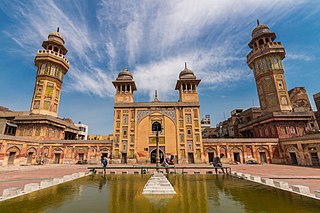
The Wazir Khan Mosque is a 17th-century Mughal masjid located in the city of Lahore, Punjab, Pakistan.

The Masjid-i-Jehan-Numa, commonly known as the Jama Masjid of Delhi, is one of the largest mosques in India.

Mehrauli is a neighbourhood in South Delhi, Delhi, India. It represents a constituency in the legislative assembly of Delhi. The area is close to Gurugram and next to Vasant Kunj.
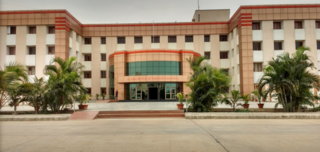
Phulwari or Phulwari Sharif is Block and town in Patna district in the Indian state of Bihar. It is included in the Patna Metropolitan Region and is one of the fastest growing area of urban Patna. The civilisation of the city dates back to the days of inception of the Sufi culture in India. Phulwari Sharif had been frequented by most Sufi saints of that period and is famous for its islamic spiritual dargah and old mosques.
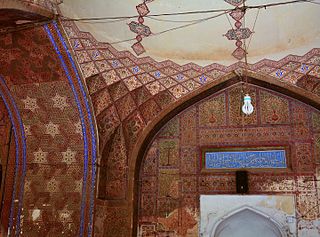
Begum Shahi Mosque, officially the Mosque of Mariyam Zamani Begum, is a 17th-century mosque situated in the interior walled city of Lahore in Punjab, Pakistan. Constructed by Mughal empress Mariam-uz-Zamani, chief consort of Akbar. The mosque was built between 1611 and 1614 during the reign of Jahangir.
Indian Mujahideen (IM) is an Islamist terrorist group which has been particularly active in India. The jihadist group was founded as an offshoot of the Students' Islamic Movement of India (SIMI) by several radicalized members including Iqbal Bhatkal, Riyaz Bhatkal, Yasin Bhatkal, Abdul Subhan Qureshi, Amir Reza Khan and Sadiq Israr Sheikh, among others. It has been active since at least 2005 when it bombed the Dashashwamedh Ghat in Varanasi. It carried out several serial-bombings in Indian cities in the following years notably the 2007 Uttar Pradesh bombings, 2008 Jaipur bombings, 2008 Ahmedabad bombings, 2008 Delhi bombings, 2010 Pune bombing, 2011 Mumbai bombings, 2011 Delhi bombing, 2013 Patna bombings, 2013 Hyderabad blasts and the 2013 Bodh Gaya bombings.

Sher Shah Suri Mosque, also known as Shershahi Mosque, is a mosque in Patna, the capital city of the state of Bihar in India. It serves as an example of the Afghan style of architecture. Sher Shah Suri built this mosque in 1540–1545 to commemorate his reign. It is sited in the south-west corner of Purab Darwaza near Dhawalpura.
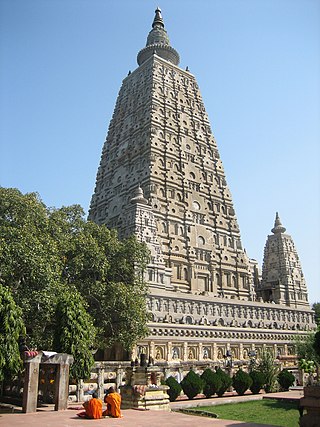
The state of Bihar in eastern India, is one of the oldest inhabited places in the world with a history going back 3000 years. The rich culture and heritage of Bihar is evident from the innumerable ancient monuments that are dotted all over the state. Bihar is home to many tourist attractions and is visited by large numbers of tourists from all over the world. Around total 6 million tourists visit Bihar every year.

Moth ki Mosque is a heritage building located in Delhi, and was built in 1505 by Wazir Miya Bhoiya, Prime Minister during the reign of Sikander Lodi (1489–1517) of the Lodi dynasty. It was a new type of mosque developed by the Lodis in the fourth city of the medieval Delhi of the Delhi Sultanate. The name of the mosque literally translated into English language means ‘Lentil Mosque’ and this name tag ‘Lentil’ has an interesting legend. This mosque was considered a beautiful Dome (Gumbad) structure of the period.

Toli Masjid, also known as Damri Masjid, is a mosque in Hyderabad, in the Indian state of Telangana. It was constructed during the Qutb Shahi period and completed in 1671.
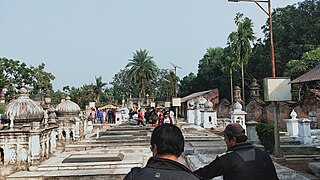
Jafarganj Cemetery is located in Murshidabad, West Bengal, India.

The Badshahi Mosque is a Mughal-era imperial mosque located in Lahore, Punjab, Pakistan. It was constructed between 1671 and 1673 during the rule of Aurangzeb, opposite of the Lahore Fort on the northern outskirts of the historic Walled City. It is widely considered to be one of the most iconic landmarks of the Punjab.

Mehrauli Archaeological Park is an archaeological area spread over 200 acre in the Mehrauli neighbourhood of the South Delhi district of Delhi, India, adjacent to the Qutub Minar and the Qutb complex. It consists of over 100 historically significant monuments. It is the only area in Delhi known for 1,000 years of continuous occupation, and includes the ruins of Lal Kot built by Tomar Rajputs in 1060 CE, making it the oldest extant fort of Delhi, and architectural relics of subsequent period, rule of Khalji dynasty, Tughlaq dynasty, Lodhi dynasty of Delhi Sultanate, Mughal Empire, and the British Raj.
Ashok Rajpath is a road in Patna, the capital of Bihar. It is named after Ashoka, an Indian emperor of the Maurya Dynasty who ruled almost all of the Indian subcontinent from ca. 269 BCE to 232 BCE. It connects Patna with Patna city or Patna Sahib. Starting roughly from Golghar, it run parallel to the river Ganges, and terminates at the Didarganj. It is a busy road owing to the presence of markets on one side and educational institute of Patna University on the other side.
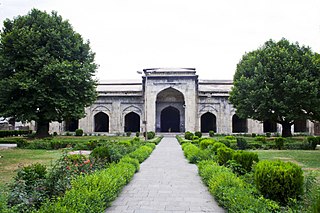
Pathar Mosque, known locally as Naev Masheed, is a Mughal era stone mosque located in the old city of Srinagar, in the Indian state of Jammu and Kashmir. It is located on the left bank of the River Jhelum, just opposite the shrine of Khanqah-e-Moula. It was built by Mughal Empress Noor Jehan, the wife of emperor Jehangir, in 1623, for Shi’a Muslim Population. Soon after its construction, the mosque was declared unfit for prayers and was used instead for non-religious purposes. The structure was reconverted into a mosque in the early 1930s. The mosque has some distinct features that separate it from the rest of the mosques in the Kashmir Valley. Unlike other mosques, it does not have the traditional pyramidal roof. Furthermore, the mosque has nine mehraabs (arches), with the central one being larger than the others.
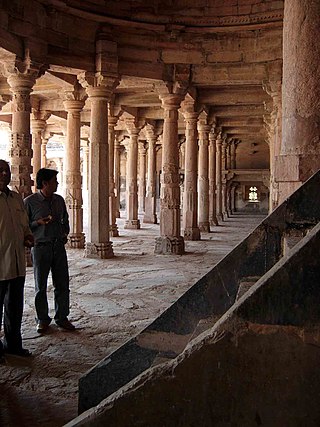
Lat Mosque is a mosque in Dhar in Madhya Pradesh, India. Named after the Iron pillar of Dhar, it is also known as Lat ki masjid, Ladh Masjid, or Lath Masjid.

The Thanesar Pathar Mosque, also known as the Pathar Masjid, is a former mosque and now historical monument, located in Thanesar, in the state of Haryana, India. Believed to be built in 17th century, the mosque is located in the Kurukshetra district and is a Monument of National Importance.
References
- ↑ "Destinations :: Patna".
- ↑ "Pathar ki Masjid". Archived from the original on 10 April 2009. Retrieved 19 September 2008.
- ↑ "इंडो-इस्लामिक कला का नमूना पत्थर की मस्जिद". Dainik Bhaskar (in Hindi). 8 June 2016. Retrieved 22 November 2022.
- ↑ "Architecture admiration tour to Pathar ki Masjid or Saif Khan?s mosque in Bihar". www.tsiindia.com. Archived from the original on 21 November 2008.